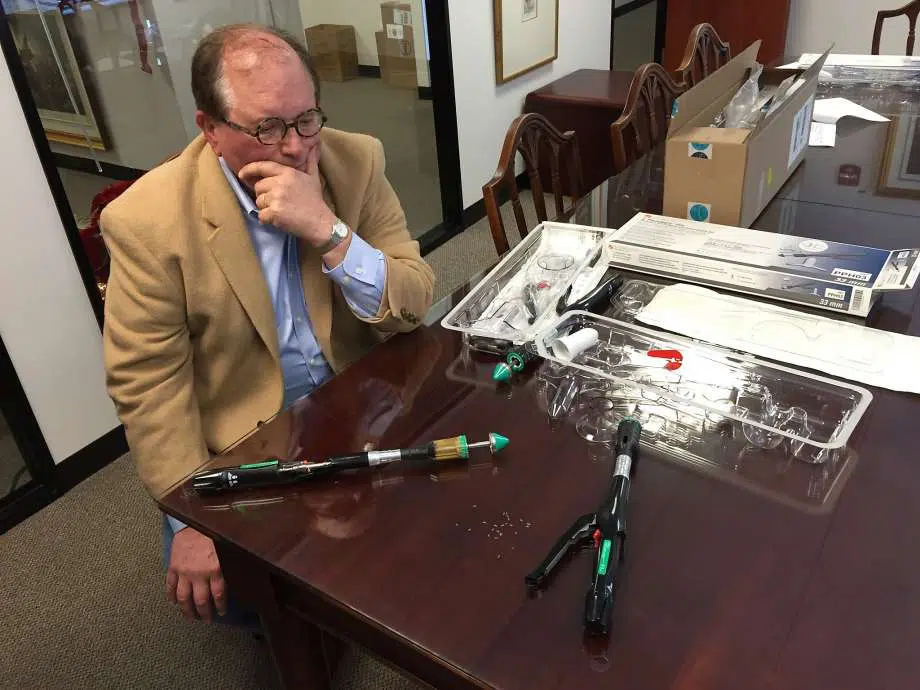Defective Hemorrhoid Stapler Case is No Joke—How Defective Medical Devices Spark Liability Lawsuits
Surgical procedures are meant to heal, so it’s alarming when a patient ends up in worse shape than before their operation. Sadly, doctors can make mistakes and medical tools can fail. When this happens because of carelessness or negligence, the patient deserves compensation.
One landmark case involves a defective hemorrhoid stapler. That might sound like the punchline for a joke, but it was no laughing matter. A patient went in for a routine procedure and ended up with life-altering injuries. In fact, she could have died. As the result of a product liability lawsuit, a jury awarded her $80 million.
Medical Devices are Designed to Help, Not Harm
New advances are made in medicine and surgery every day. Many medical devices allow surgeons to do their job more efficiently than before. For the most part, patients benefit from the use of these instruments with better results and faster recovery times.
One such instrument is the medical stapler. Using staples instead of stitches to close wounds and incisions, staplers are used in all types of surgery, both internally and externally. But anything mechanical can fail. A medical tool’s success depends on good design, dependable manufacturing practices, and transparency about proper usage and potential problems. When someone is harmed because of the absence of these factors, they have the right to compensation.
Kuhlmann v. Ethicon Endo-Surgery LLC
The hemorrhoid stapler, in this case, was manufactured by Ethicon, a subsidiary of Johnson & Johnson. In January 2012, the patient, Florence Kuhlmann, entered the hospital for a routine hemorrhoid procedure called a Hemorrhoidoplexy.
During the operation, the surgeon used a special staple gun. A manufacturing defect caused the device to malfunction. The surgeon fired the instrument once but then was unable to remove it. The only way to do so was to fire it again. The second staple essentially closed off the patient’s anal canal completely.
In the aftermath of the surgery, Ms. Kuhlmann suffered internal and external scars and a deformed bowel. She needed 21 days of emergency hospitalization, endured a massive infection, and underwent additional surgery. For four years, she used a colostomy bag.
Ms. Kuhlmann’s attorneys filed a product liability suit for compensatory damages to recoup her medical expenses, lost wages, and other out-of-pocket costs. They also asked for punitive damages, as they claimed the company knew about the defects of the device that caused the injuries and did nothing. The original suit also included a malpractice aspect, naming the surgeon. The jury found that he had not been warned by the manufacturer of the problems with the stapler, so he was not at fault.
Unlike compensatory damages, which repay a plaintiff for the money an incident has cost them, punitive damages are meant as a punishment. When someone is harmed by negligence or irresponsibility, a jury may award a dollar amount for the plaintiff’s pain and suffering. In the case of Kuhlmann v. Ethicon, the jury awarded $9.8 million of compensation and a whopping $70 million in punitive damages.
Deciding Who’s at Fault
In product liability cases surrounding medical staplers, there are five things that typically cause injury and sometimes death.
- The device can malfunction or misfire.
- There may be a problem with the design.
- The stapler may have been assembled incorrectly by the manufacturer.
- The staples rather than the stapler can cause complications.
- Failure by the manufacturer to warn users about potential problems and risks.
Attorneys for Ms. Kuhlmann discovered that surgeons had been reporting problems with the device for nearly a decade. Rather than make modifications to the design or product assembly, the manufacturer instead dismissed complaints, blaming the problems on surgeons’ errors.
Compounding the issues with the stapler’s design, was how the FDA classified these tools. Hemorrhoid staplers and other medical staplers are known as Class I devices. Class I also includes mundane items such as bedpans and bandages. This classification allows the makers of the product an exemption from reporting certain complaints. They can report them privately to the FDA, and they are not part of the public record.
In addition to the misfiring that led to this case, defective medical staplers pose other potential problems. They may jam, forcing surgeons to use another method when closing an incision. This results in a delay that can lead to additional blood loss or exposure to infection. The devices can use too much force, causing tissue damage, or too little force, leaving open wounds. They can also fire accidentally or inaccurately, ending up in the wrong place.
The Claim of a Defective Hemorrhoid Stapler, and the Jury’s Finding
The jury in the Kuhlmann v. Ethicon case decided that the force needed to fire the stapler was much more than shown in the product specifications. This caused difficulty for the surgeons operating the device. Ultimately, the manufacturing processes were found to be defective.
Since the company had known of the issue but had not warned surgeons of the tendency of the stapler to misfire, the jury found only Ethicon, and not the surgeon, to be liable. The manufacturer’s prior knowledge and the fact they neglected to remedy the situation are what led to the large punitive award.
The plaintiff’s attorneys presented evidence that about one-third of all hemorrhoid staplers on the market shared the same problem. A few months after the verdict, Ethicon finally acknowledged the device’s defects and issued a recall of approximately 157,000 hemorrhoid staplers. This is a case that not only benefited the victim but potentially helped numerous patients avoid harm in the future.
The company challenged the punitive portion of the case, arguing that the amount was constitutionally excessive. The defense argued that the jury based the amount more on the net worth of the defendant (Johnson & Johnson) instead of something fair and balanced. The judge agreed and lowered the punitive damages from $70 million to $19.6 million, twice the amount of the compensatory damages.
Proving a Medical Product Liability Case
When an individual files suit in a product liability case, there are four points their attorneys must prove.
- The company owed a “duty of care” to users of the product
- That duty was breached with willful disregard
- The company’s negligence was the cause of injury or death
- The individual suffered compensable damages
Depending on the details of the case, the lawsuit might name the manufacturer, the lab that tested the product, and the doctors and hospitals that used it. It may also include the marketing firm that sold the product to the doctors or hospitals, as they may have failed to disclose information regarding potential problems.
Product liability cases, especially in the medical field, are complex. They deal with complicated issues that truly hold lives in the balance. If you have been harmed by a medical device, you need an experienced and diligent product liability attorney to help you reach the settlement you deserve. Hipskind & McAninch would be happy to discuss your case.
Category:
Serious Injuries, Product Liability
Tags:
medical device, medical malpractice, personal injury, product liability

